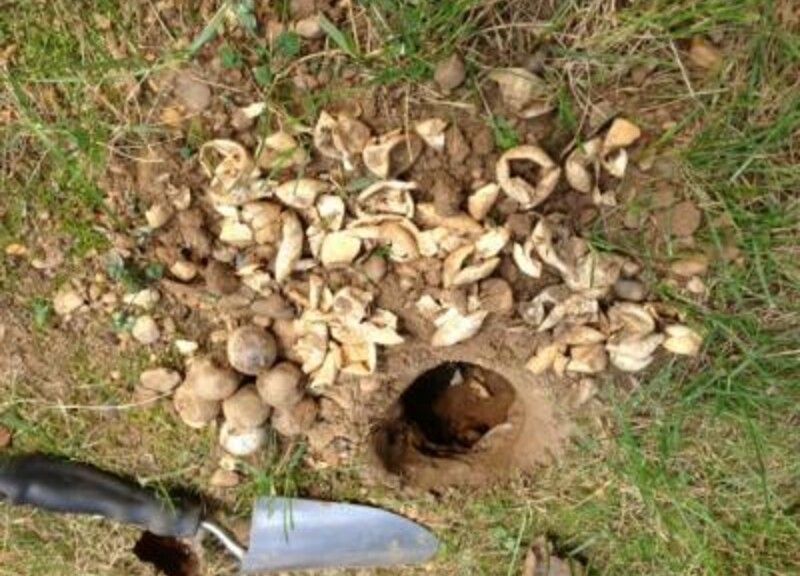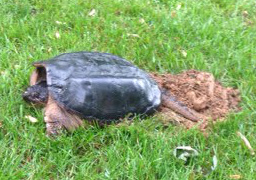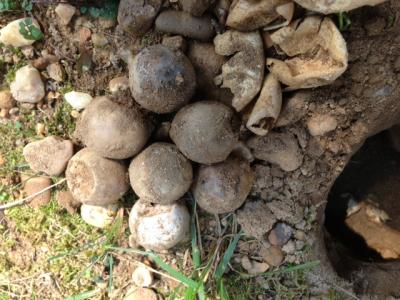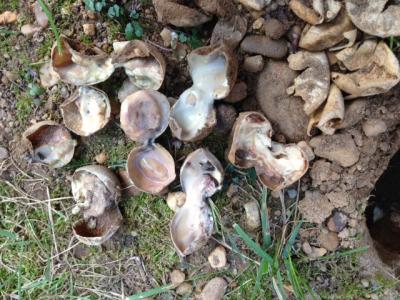
Turtle Report

For those Club members in attendance at the 2014 Volunteer Party in early August, there was a peculiar type of lawn ornament that some took an interest in. I’m giving a follow up report regarding the “turtle nest guard” that was present. Some of you had asked to be told of the outcome from the project.

On the cool rainy morning of Wednesday May 27th, I noticed the presence of a rather large female snapping turtle laying her eggs in the yard soon after daylight. She had already dug the hole for depositing her eggs and was in the process of such when I first saw her. I watched her on and off for about 3 hours and took a few pictures, trying to be careful not to disturb or interrupt her. I never knew how many eggs she laid and she covered everything up and tamped it down without me seeing her leave the site.
I have experienced the aftermath of predation of turtle nests in the past, and was always saddened by the remains of rolled up turtle egg shells that were dug out by foxes, raccoons, possums, or ? The telltale sign of a mishap was the large dug hole into the “nest” and the residual eggshells having been pulled out to the surface with the contents having been consumed. In an attempt to prevent this, I fashioned a wooden pallet with mesh wire to allow sun and warmth to get to the ground, but heavy enough to dissuade a potential marauder. Whenever the grass was cut I would pick up the guard and replace it in position after mowing.

From an earlier experience years ago, I was expecting the eggs to hatch after about 90 to 100 days of incubation. When the eggs hadn’t hatched after well-over 100 days, I was beginning to feel discouraged about the success of the nest. I even tried to rationalize that the relatively cool summer may have caused a delay in the incubation time.

Over the weekend of September 26-27-28-29, I was away from home for almost four days. On the morning of Tuesday September 30, I was checking the nest and noticed a very small slot hole on the edge of the disturbed soil. This was over four months since mama had laid her eggs in May. I proceeded to gently dig out the nest with a trowel to see what remained under the surface. As I dug it out there was an apparent dirt ramp leading to the surface opening from the cavity of the nest 9-10 inches below the surface. At the bottom of the cavity there was a jumble of leathery eggshell pieces, but also a grouping of discolored round eggs that hadn’t hatched. The best I could determine there were 16 eggs that had hatched, but definitely 7 eggs that hadn’t hatched.

After a mama snapping turtle lays her eggs, her job is done. There is no other protection for the babies once they hatch other than crawling away to cover and going downhill to find a suitable wetland habitat to live near. The eggs are spherical and smaller than a Ping-Pong ball in size. I’ve seen recently hatched snappers before, and they are smaller than a quarter in size with a long out-of-proportion sized tail.
I was curious what was inside the unhatched eggs so I cut into them to see. Each of the seven was filled with a stinky mush with no indication of any development of the embryo. I don’t know why they were all clumped close together within the cavity, but it may have been because of too much/little moisture in that part of the cavity (?)

I wondered if 16 of 23 successful egg hatchings are normal for a snapping turtle nest. If so, the 69% is about the same success ratio for a runner completing a century run. I was also reminded of the saying as a youngster: “the last one out’s a rotten egg”. Sadly, in this case, there were seven of them.
Happy Trails,
Gary
